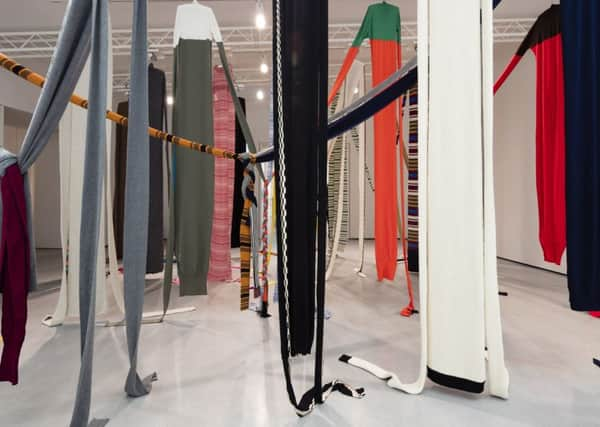Body of work


The Hepworth Wakefield continues to distinguish itself as one of the most exciting contemporaray art spaces in the UK with its bold and imaginative approach to programming and curation.
Its latest exhibition Disobedient Bodies, which opened last month, is a perfect example. Curated by designer Jonathan Anderson, one of the most distinctive, acclaimed and innovative voices in contemporary British fashion, it is the first in a planned series of shows curated by key figures from creative fields outside the visual arts including music, filmmaking and literature.
Advertisement
Hide AdAdvertisement
Hide Ad“Jonathan mentioned Hepworth in a magazine interview and said that he was interested in her work,” says Andrew Bonacina, chief curator at the Hepworth.
“As a curatorial team we had already been talking about how people are engaged with different design forms and how we could reflect that by bringing in new viewpoints and perspectives and Jonathan seemed like the ideal first candidate. It is really about finding the right person. The plan is to do a show like this every two years, the next one will be in 2019. So we will be looking at musicians, writers, filmmakers and obviously whoever we choose will have a genuine interest in and engagement with the narrative of the visual arts.”
Anderson came to spend time with the collection, looking at Hepworth’s early work – as well as the work of Henry Moore – and using that as a starting point. The work of both sculptors in the 1920s and 30s was at the cutting edge of representing the human body in the abstract. “Jonathan appreciated how radical that moment was, so that is how the theme of ‘disobedience’ emerged,” says Bonacina.
He explains that the show – which explores how the human form has been reimagined by artists and designers through the 20th and 21st centuries – has evolved through conversations between himself and Jonathan over the course of two years. “He has brought something to the table and so have I. It’s been a complete and very steep learning curve,” he laughs. “We talked about the tendency of institutions to categorise things as art or fashion but those boundaries are really breaking down. Things are talking to each other much more so we wanted to present them on a level playing field, looking at it partly in terms of form or materials or a creative moment.”
Advertisement
Hide AdAdvertisement
Hide AdThe exhibition presents a personal selection of more than 100 objects – the most that have appeared together in a show at the gallery since it opened – taking in art, fashion, ceramics, textiles, design, film and even furniture in quirky and thought-provoking groupings.
The blurring of the lines between art and fashion is imaginatively explored and there are some wonderfully witty juxtapositions of objects such as the placing of one of Moore’s reclining figures next to a Jean-Paul Gaultier ‘cone’ dress from the early 1980s lying horizontally on a plinth. Similiarly a Yohji Yamamoto Bustle Coat finds an echo in William Turnbull’s Metamorphosis. There is something joyful, cheeky and humorous about it all. “I hope that the freedom and playfulness that have been part of the curatorial process is evident to the visitors,” says Bonacina. “It is an attempt ot look at things afresh and encourage people to view something in a completely new way. Often we give more value to art than fashion and that is something that the show questions.”
An exquisite black Yves Saint Laurent evening dress, borrowed from a private collection, with a bronze central piece that is a cast of the model’s naked waistline almost literally, combines sculpture and fashion, in one piece.
The exhibition offers an incredbily rich visual experience for the visitor and throws up interesting questions, inviting the viewer to make associations for themselves. “We removed all the interpretive signage from the gallery,” says Bonacina. “We are just making a suggestion of how the various objects might speak to each other – I will see one thing but someone else might see something completely different.”
Advertisement
Hide AdAdvertisement
Hide AdThe centrepiece of the whole show is a large-scale interactive installation comprising super-elongated versions of oversized jumpers which featured in Anderson’s own menswear spring summer 2017 connection. “From the very beginning Jonathan wanted to do something that was really tactile,” says Bonacina. “So he created this ‘forest’ of oversized jumpers.”
Visitors are encouraged to touch the garments and drape them around themselves, transforming their own bodies into abstract forms. Apart from that, it is about as close to wearing haute couture as many of us will get. And it’s fun.
The Hepworth has worked with 6a architects to transform the galleries, dividing them into smaller room spaces using curtaining, made out of fabrics from Anderson’s archive. The idea is to give the impression of an intimate social gathering. It works – it really does feel as if you are at a party where the conversation is free-flowing and frequently goes off at interesting tangents.
“Doing a show like this has been fascinating,” says Bonacina. “I’ve learned more about fashion than I thought I would ever know and it has made me look at sculpture with fresh eyes which has been really exciting.”
Advertisement
Hide AdAdvertisement
Hide AdDisobedient Bodies is at the Hepworth Wakefield until June 18. www.hepworthwakefield.org
***
Jonathan Anderson was born in Northern Ireland in 1984. He studied menswear at the London College of Fashion.
His label JW Anderson was established in 2008 with a menswear collection and he launched a capsule collection for women in 2010.
His brand is award-winning and internationally renowned, presenting a modern interpretation of masculinity and femininity with experiments in non-gendered garments.
Anderson was the first designer to win both womenswear and menswear designer in the same year at the British Fashion Awards 2015.